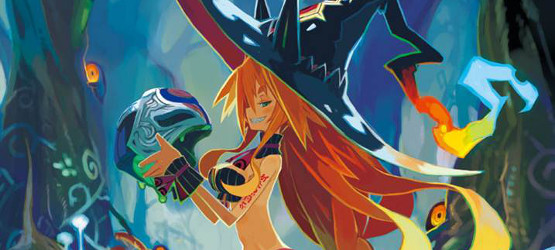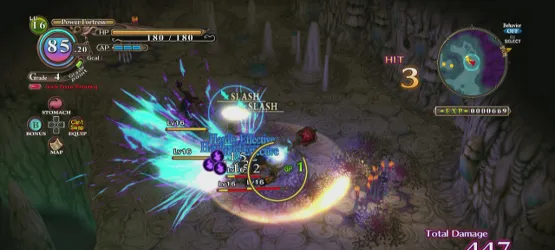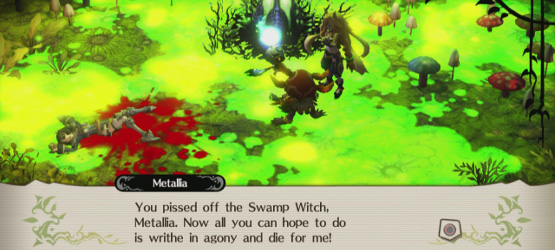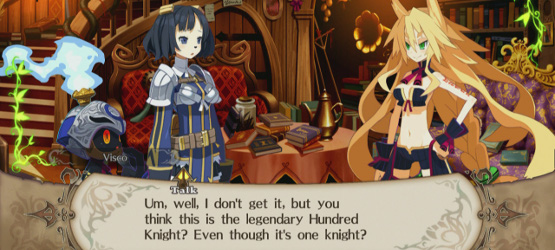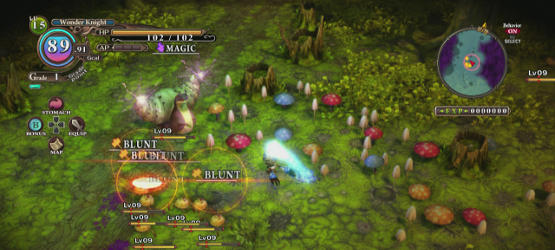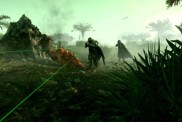Witch and the Hundred Knight is an action RPG from the makers of Disgaea, known to create a mixture of dark and oddball humor with surprisingly deep yet fun gameplay mechanics. The game stars Metallia, an extremely powerful witch living in a swamp and her freshly summoned minion, the mute and sidekick-adorable Hundred Knight. Players take on the role of Hundred Knight to do Metallia’s bidding.
Combat and level exploration in Witch and the Hundred Knight will take up the bulk of a player’s time. Hundred Knight functions more as a Rogue-like than a straight up action RPG. The map for each level is revealed as Hundred Knight makes his way to his goal. While maps are static and do not change, the obtainable items are randomly generated and placed throughout each level. This search system is both complimented and confounded by the Gigacal system. Gigacals are what keep Hundred Knight hale and hearty, and are constantly lost as Hundred Knight explores each level. Gigacals also regenerate health when damage is received. Once Gigacals run out, Hundred Knight is hit with a 30% strength and defense debuff, and his hit points start to drain. Eating enemies, items, and spending bonus points can restore Gigacals; but these systems also have limits. It is more likely players – especially at the beginning of the game – will have to enter levels a couple times to complete objectives.
Combat is combo-based, and up to five weapons of three different attributes can be chained together. The attributes function as a rock-paper-scissors system against enemies weak to one or more of the attributes. There are other types of attacks and combat systems available, but the above is Hundred Knight’s initial bread and butter. In fact, Hundred Knight features a whole slew of systems and options available to customizing the way the game plays; but these systems do not come together until the player has put a lot of time into the game. Until then, players will be mostly using the game’s then-mediocre combat and exploration system to trudge through the levels. Once Tochkas; support units and abilities for Hundred Knight, become available and Hundred Knight’s ability to consume enemies has been expanded; combat and exploration begin to move beyond mediocre and into above average territory. The several gauges and systems begin to interact more smoothly with one another, and coupled with the game’s increasing difficulty Witch and the Hundred Knight eventually blossoms into the realm of decent gameplay.
Difficulty, as stated above, steadily increases as players make their way through the game. Stats are not the only things affected; enemies will gang up and juggle Hundred Knight if possible. Grinding for levels and weapons may be necessary to overcome later challenges. The difficulty is further increased by status effects which keep hitting Hundred Knight during times he is normally invincible, such as activating a switch. Since HP can be depleted before the action ends, players will have to be careful about doing mundane actions while under a status effect. Enemies will also keep moving during the quick time event where Hundred Knight eats an enemy. It is often possible to come out of the QTE flush in the middle of an unavoidable attack. Should the difficulty become too great, a casual mode is available outside Metallia’s house. Casual mode greatly reduces enemy stats but not attack patterns. Players will survive being juggled by opponents but will still have to find a way to outfight enemies. This means players will have to experiment with different weapon combos and skills to get through the game.
Players looking forward to zany Disgaea-esque hijinks and memorable characters are going to be heavily disappointed. Story progression and characterization is terrible. Hundred Knight is a mute protagonist with very few chances to answer questions. Only once in my playthrough did any of the choices offered actually affect the outcome of an event, and at that time it is to choose an ending. Therefore, Metallia is the main voice of the game, and while I try not to spoil plot; the ending of the first chapter is probably the best indication of characterization in Hundred Knight. Upon conquering her long-time rival and apparent mother, Metallia transforms her into a self-aware mouse and then summons a bunch of horny male mice to chase her mother down and rape her. Metallia thinks this is hilarious. Not only is this scene several levels of abhorrent; we later find out the retribution is even more incredibly disproportionate. She simply did it to be cruel.
This sets the stage for the game. The above scene is Hundred Knight’s unfortunate price of admission. The game is telling players to walk away if this offends you. For the next 30 or so hours, players will find out Metallia’s defining traits are power, selfishness and cruelty. The game goes a long way to explain most witches are like this, but few witches are shown to harbor Metallia’s cruelty. There are times when enemies will utter some terrible phrase about which way they like their enemies killed, but players are constantly treated to Metallia’s threats so often villain dialogue falls on deaf ears. Only one antagonist in the game is able to exceed Metallia’s level of cruelty, and by the time this event does happen, there is little reason to care about what he has done since players will most likely be sick of spending their game time with the game’s lead.
Other characters may not be as bad as Metallia but are either annoying or incredibly stupid. A running joke is to ask Hundred Knight details on his surroundings and expecting a vocal response, but Hundred Knight is mute. Hundred Knight gets a pass on characterization because for the most part he; and by association the player, are literally standing by until someone barks an order to go do something. Hundred Knight is a slave who can shake his head one of four ways, and even then very rarely. Not even the levels are a safe escape from the inane and terrible characters, because Hundred Knight is reachable via telepathy all the time. It is a sad moment for the game when the most enjoyable chapters occur when players have the least amount of interaction with Metallia and company.
Most of Hundred Knight’s plot involves deus ex machina, plot holes, and people who have what they refer to as “wisdom” but lack basic communication skills. Hundred Knight does have storytelling – it’s locked in the same basement with characterization and is abused with the same regularity. For instance, if there is one positive aspect about Metallia, it is her intelligence; which she is uses to keep each situation’s odds in her favor. Her only weakness is being away from her home swamp for extended periods of time. Without the swamp to “recharge” Metallia, her powers and health begin to deteriorate. She goes to great lengths to ensure she is not caught in such a state. In fact, Hundred Knight’s main task is to expand her swamp throughout the land, and thus expand her power base and ability to travel the world. So of course later in the game she ignores recharging and pays the price. She could literally walk to one of these extensions, teleport back the main swamp and sleep overnight, and teleport back to her starting position with no problems. But she does not, because the plot requires her to be stupid. Moreover, the events strip Metallia of her best qualities – Players may not like Metallia due to her actions, yet there is no doubt she is, up until this point; a powerful and capable character.
Most of Hundred Knight’s errands are superfluous and there is a lot of filler in the game. The last two dungeons of the main storyline are unnecessary. The penultimate dungeon Hundred Knight could literally skip past if a plot coupon had not been lost by a member of Team Metallia, and the last dungeon is a plot hole. Players are dropped off in the area the boss battle takes place, wander through a whole dungeon, and come out right where they were dropped off during the pre-dungeon cutscene. This level of absurdity is staggering.
Graphically the game is a mixed bag. In-game models are okay and decently detailed, but look terrible the rare instances the game zooms closer. Levels and backgrounds contain a lot of detail but lack a lot of the color found in previous Nippon Ichi titles. Too many characters on the screen will cause the game to chug a little, and during combat the game will often hang for a split second. The best graphics come in the form of the game’s character portraits, which are mostly very good; though for the life of me I cannot figure out how Valentine’s breasts work. I’m guessing witchcraft.
Speaking of graphics, Hundred Knight tends to tell and not show in its presentation. Because most of the plot takes place when the portraits are active, players are treated to text about how someone was suddenly stabbed instead of showing it. Plot dumps at the beginning and end of chapters are to blame, but assets for being slashed and blood covering the ground are inside the game since Metallia or Hundred Knight often cause such events. When action is the focus of gameplay it helps to show the action instead of talking about it.
Music in the game is very good. It’s almost like a mixture of Disgaea tracks and Falcom’s in-house band. A few of the tracks even feel like they push the player forward in combat and exploration. Sound effects are fun and suit the situations quite well.
Levels are large and can be anywhere from simple to labyrinthine. Players who like to explore will have their hands full. Levels may not always look like much, but they are huge and vary from narrow pathways to warp dungeons to open fields. Wooded and dungeon levels have a few problems. The overhead to ¾ view causes the surroundings to get in the way of the player’s view, which includes combat. Players will often turn a corner and have to readjust the camera from an obscured view to something less awkward.
Witch and the Hundred Knight offers both English and Japanese language tracks. The translation is decent, but can at times be awkward. Additionally, there is a new game plus option wherein players keep all of the Hundred Knight’s levels and items. Should players try for the third, hidden ending or bonus dungeon another 10 or more hours is available to play. I clocked in about 36 hours for the True ending, which is not the secret ending you may think it is.
Witch and the Hundred Knight has its strengths in combat, exploration, and the related systems; though it will take a lot of time before these systems come together. The terrible characters and pointless events are likely going to sour the mood for many players. The scenes with the most impact are not for the faint of heart, and that is if players are able to develop an emotional tie with the characters or can get beyond the first chapter’s terrible closing events. The game’s music is a definite high point, and there is plenty of extra stuff to do. However, I don’t recommend Witch and the Hundred Knight. But should someone choose to play Witch and the Hundred Knight then short bursts of one-two chapters would probably be best. After all, dealing with the plot and characters for an extended playthrough may turn players off permanently.
-
Very good music.
-
Combat does grow on the player once all of the gameâs systems and options open up.
-
Multiple endings for the inclined.
-
Characters. All of them.
-
Plot and its presentation.
-
It will take a lot of time before the gameplay comes together as an above average experience.
